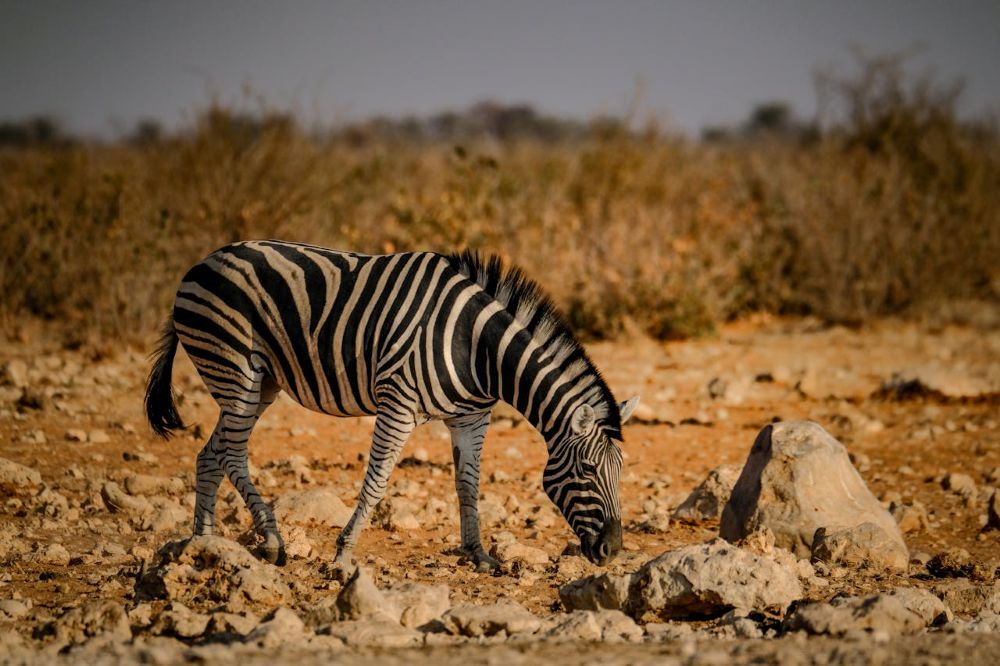It doesn’t take a rocket scientist to know one of the top African hunts destinations of Namibia is a desert. Deserts are known for minimal rainfall and unpredictable weather patterns, but what happens when these natural systems fall out of sync, and what was once an arid place, now has very scarce rainfall, and natural water sources are drying up faster than before? Hunting in Namibia is a major source of income and investment, and with drought affecting both the animals and the safari hunting operations, how will the industry keep up going forward and how will the government’s actions affect the future of an industry it’s come to rely on?
[DYNAMIC-BLOGTABLEOFCONTENT]
Key Takeaways
- Namibia is currently experiencing its worst drought in over 100 years.
- Hunting in Namibia is in the spotlight as the government implements cull hunts.
- It needs to be stated that the hunts offered as part of this culling are not considered trophy hunts and no trophies will be allowed to come from them.
- Namibia has extended its hunting season until 31st December 2024.
- To hunt in Namibia at this time means being aware of changes in animal behavior and the environment in general.
- Be a good sport and abide by any changes to quotas, regulations, and measures implemented to conserve water.
- The future of these African hunts may be affected for years to come, so be responsible in your practices.
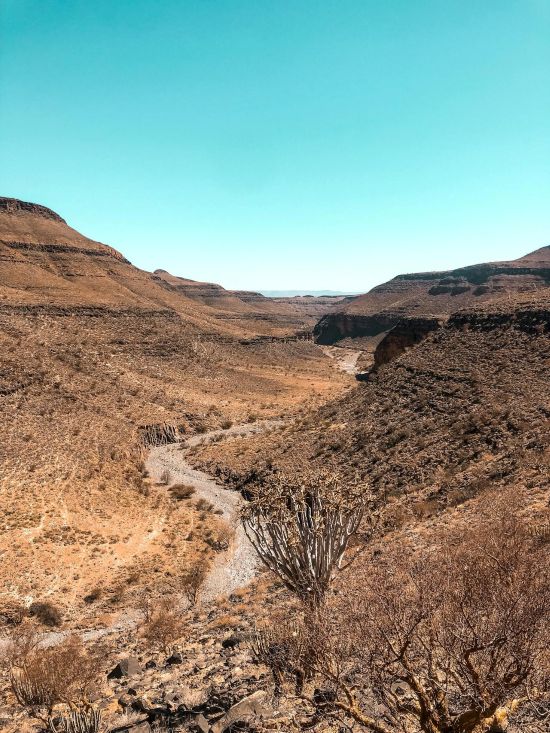
Safari Hunting in a Drought: What is the Situation in Namibia?
Namibia’s Climate and Drought History
The only area on Earth that is more arid than the Namib is the Sahara.
Namibia’s region along the Atlantic generally receives around 3 inches of rain annually, while other areas average around 0.2 inches annually. One of Namibia’s most impressive (and much-needed) climate phenomena is its banks of fog that roll in when the cold Benguela currents meet the warm Hadley cell and cover vast expanses of the coast and inland desert regions in a thick moisture-rich fog.
Namibia’s most recent drought occurred in 2018/2019 and wreaked havoc on agriculture and wildlife-related lands and activities. Prior to this, Namibia experienced 2 other droughts in the 2010s, two in the 2000s and three in the 1990s. Namibia’s current situation was linked to low rainfall from around October last year and continuing El Nino weather patterns which have led to five other Southern African countries declaring a state of drought disaster.
Where Are We Now?
Namibia declared a state of emergency in May this year, and since then things have not improved as many would have hoped. Crop data shows decreases of over 50% with the country’s food reserves sitting at around 16% according to the Namibian parliament. Dam levels are 15% lower than last year, with major areas like Windhoek bearing the brunt of the scarce water supplies.
With its vast expanses of land drying up and withering further into desolation; the lifestyles of those in Namibia are being forced into change for the worse, and with little hope on the horizon for drought-breaking rainfall, it seems like Namibia will be having a tough number of months ahead.
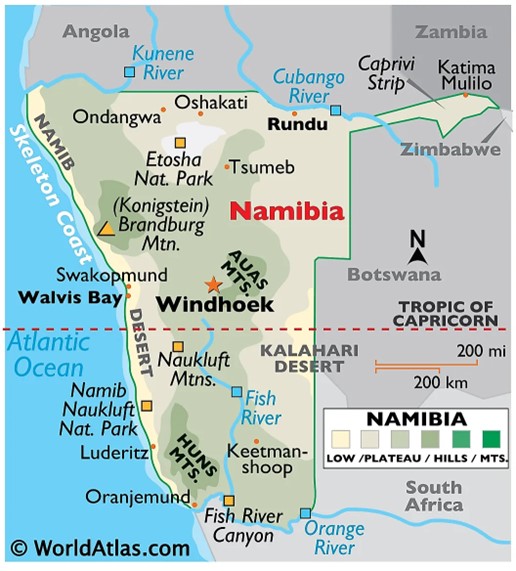
The Big Cull: Sacrificing the Hunt in Namibia for Food
In September, Namibia announced a plan to cull over 700 game animals as a measure of providing food to its inhabitants struggling with the effects of the 2023/2024 drought. This culling has been broken down as follows:
- 83 elephants
- 30 hippo
- 60 buffalo
- 300 zebra
- 100 eland
- 100 wildebeest
- 50 impala
The news fallout of the above announcement has angered conservationists and media outlets alike with many calling the planned culling short-sighted and a temporary fix to a long-term issue. Namibia has been praised over the years for its efforts in improving wildlife numbers and creating sustainable populations; but with these populations further straining the environment and many vulnerable population groups going hungry, it seems Namibia has had a difficult decision to make and they have no doubt thought it over.
Namibia’s Ministry of Environment, Forestry, and Tourism (MEFT) has repeatedly tried to assure the broader public and conservation groups alike that this cull is being done with the best intentions and aims to relieve both the strain on the natural environment and the food insecurity currently being faced by populations across the country. The culls are taking place in several national parks and reserves, and are being carried out by registered outfitters and licensed professional hunters. Since the announcement in September, around 280 animals from the above list have already been culled.
A major concern being voiced is that this move will set an example other drought-stricken countries like Zimbabwe, Botswana, and Zambia (all famous destinations for African hunts) could follow; further endangering wildlife numbers and stunting their respective safari hunting industries.
Critiques of Questionable Motives and Track Records
There are those arguing that this cull is a political power move by the government to score favor during a contested election year, early reports show the proceeds of Namibia’s big cull being set aside for areas where political activity is high.
Other wildlife-related efforts linked to “benefitting Namibia” include previous attempts to auction elephants, rhino calves, and other animals to zoos; and even a fling at auctioning the country’s stockpile of ivory, which almost anyone knows is illegal.
Support for Namibia’s Move to Cull in the Face of National Disaster
Almost half of Namibia’s population is facing a lack of food due to the drought, and this reality will get worse unless a miracle of a rainy season occurs soon. A portion of the animals earmarked for the culling, inhabit land that is shared with agriculture and other activities that bring wildlife into close contact with human populations.
Thus, the cull has been supported by the Namibian Chamber of Environment as a way to mitigate human-animal conflict and further reduce the potential stress and damage to an ecosystem already under strain to produce. By reducing the wildlife populations (especially of high-consumption animals like elephants and hippos) Namibia hopes to “free up” food sources like grasses, thicket, and brush for other animals to consume and survive.
These cull hunts are also being seen as a way for outfitters to generate an income from the opportunity to hunt in Namibia at a reduced rate and to take advantage of the hunting season which has been extended end of December 2024. Hunting in Namibia generally runs from February to November, so this has been seen as a bonus opportunity for the industry reliant on wildlife resources for its success.
What this Cull could Mean for Hunting in Namibia and the Broader Industry
Despite the support and rationality given towards Namibia’s cull, there are those who argue that the way these hunts will be marketed and shown on social media will further fuel the fire of anti-cull groups who could (and would) call for boycotts of not only Namibia’s hunting safari industry, but the tourism space in general as related government departments have come out in support of this move.
It needs to be stated that the hunts offered as part of this culling ARE NOT CONSIDERED TROPHY HUNTS and no trophies will be allowed to come from them. Funds generated from these hunts will also be siphoned back into the programs and communities involved in conservation efforts and those who allow wildlife like hippos and elephants to cross or use their land for grazing.
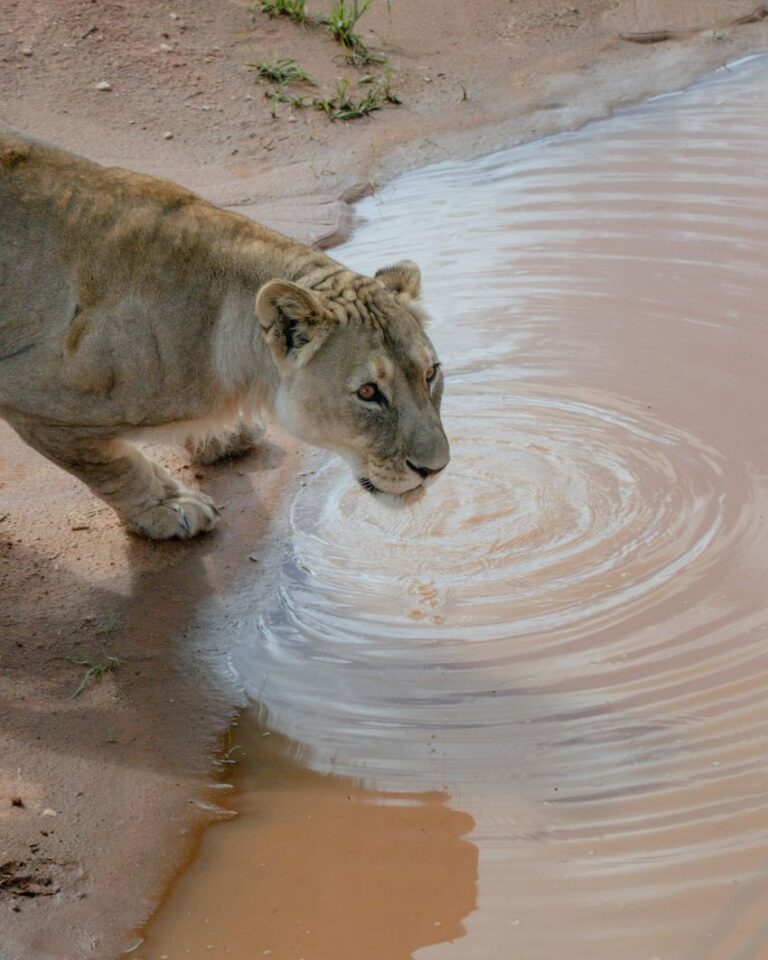
Hunting in Namibia: How Drought is Affecting Some of the Desert’s Famous Game Hunting Species
Animals are very much like humans in that when our environment goes through a major change or shift in what is considered “normal” our thinking, attitudes, and even reasoning take a turn we wouldn’t normally expect. Drought affects the game hunting environment in many ways, and hunting in Namibia, a country already arid and strained, during a time like this means accounting for the fact that animals may have changed their courses and behaviors.
For animals, drought is a way of nature, weeding through the weakest links and ensuring the survival of the fittest and most determined. To them, it is as natural as day and night, and while human interventions seem humane, they can disrupt “nature” and cause further human-animal conflict in the future.
Lion
Ironically, the Kings of the Jungle are often the ones who benefit from drought disasters in the beginning. Predators such as lions grab the “buffet” with both paws, pouncing on prey animals weakened by a loss of crucial water and plant sources.
Later, lions will compete with other predators like leopards, jackals, and wild birds for a dwindling supply of plains game. During these times groups will splinter into smaller numbers, ensuring less sharing of food, while at the same time reducing their security and ability to protect cubs or key pride members.
Elephant
Elephants feel the brunt of drought in two ways; firstly, through the loss of water and food vegetation. These pachyderms spend an estimated 75% of their day eating and consume around 300 pounds of food a day during good times. To wash this down, elephants have been known to drink between up to 50 gallons of water a day; so it’s easy to see just how badly a severe drought can diminish the nutrition of elephants.
Secondly; the older generations of the herd tend to fall first, either due to hunger/dehydration or through becoming stuck in muddy pools and being unable to free themselves. At times when park rangers have freed stuck elephants, the animals tend to pass away on the bank or near the sight due to exhaustion and lack of food. Being a matriarchal group, for elephants to lose their leader when a successor hasn’t been determined can be a huge detriment to the herd as they no longer have the necessary guidance to find their means to survive. Another issue befalling elephants is the loss of older, dominant males who keep younger males in line. Without these old bulls, juvenile males become unruly and cause unnecessary battles for dominance or reproductive opportunities. Drought impacts an elephant’s ability to reproduce and expectant cows can miscarry, or due to a lack of milk supply, can lose their calves to starvation.
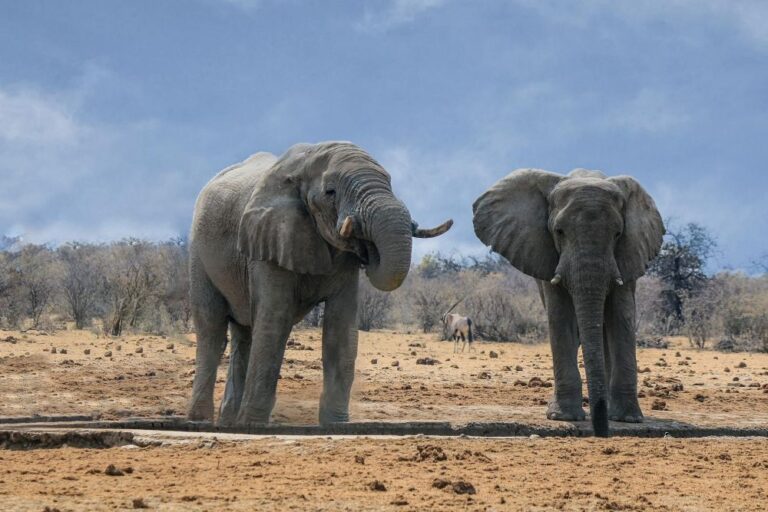
Hippopotamus
The first impact drought has on the hippopotamus is drastically reducing its habitat. Hippos are known as the Water Horse for a reason, spending the majority of daylight hours wallowing in water to keep cool and protect their sensitive skins from the sun. When these water sources dry up or become unusable the hippo also loses out on food, and when an animal is used to consuming around 100 pounds of vegetation a day, being forced to go on a diet doesn’t go down well.
Loss of water and vegetation forces hippos to travel further at night or even during the daytime, leaving them vulnerable to predator attacks and heat/dehydration-related issues. Hippos who find themselves stuck in the muddy remains of a watering hole become sitting ducks for crocodiles, lions, and even their fellow hippos who when push comes to shove are known to resort to cannibalism as a means of survival.
Crocodile
Much like with lions, crocodiles have it good during the first half as animals crowd any remaining water sources, almost ignoring the impending danger under the shallow waters. Crocs will seize this shot at fattening up before their luck runs out, making the most out of other’s desperation.
The downside is that as with hippopotami, crocodiles rely heavily on water sources as a supply of both food and habitat. Spending most of their time in or around water is how a crocodile regulates body temperature and protects itself from the sun. Crocs have been known to dig holes in the soft mud and “bury” themselves for dry season spells, but when drought levels are this extreme, that option goes out the window.
Plains game
Plains game such as antelope, zebra, and wildebeest often bear the brunt of drought episodes due to their larger populations and similar diets. Vegetation is one of the first things to wither away when rain is scarce, and weakened plains game make for easy targets to lions, jackals, and other predators like crocodiles.
Plains game migrations are also greatly affected by drought as worn-out and starved animals cannot travel the same great distances they generally do; meaning that larger numbers converge on whatever available resources they can find and rapidly deplete them. Much like with elephants, drought affects their reproduction and the survival of their juveniles either due to lack of nutrition or adults being too weak to fend off predators as they normally would.
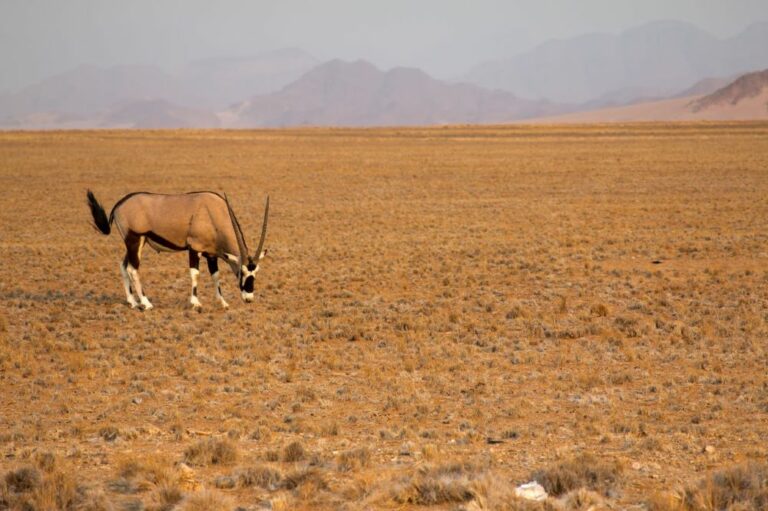
How Drought Affects the Game Hunting Industry: From the Environment to Availability
For countries such as Namibia that have a set start and end to their safari hunting season, role players may be forced to extend the season or run an open season. As mentioned previously, hunting in Namibia has been extended, rather than the usual November cutoff. By changing the season, Namibia has allowed for further advantage to be taken of the cull hunts offered and bring in some more income before other measures need to be taken.
Many of the Namibian hunts (especially on government land) are dictated by quotas, and with some of the major cull animals also being desired targets to hunt in Namibia, quotas have no doubt been adjusted to accommodate the special circumstances in which the country finds itself.
How to Hunt in Namibia During a Drought
First and foremost, as there have been changes to game hunting packages offered, hunters need to be aware that these African hunt offerings may not provide the trophies they desire. Cull hunts such as these are non-exportable and are purely for the experience and end goal of supplying food to desperate communities.
Secondly, hunters may need to travel further or to areas where they wouldn’t normally hunt as a first choice. To check the hunting area, speak to your hunting broker or outfitter for more information and guidance on the area your hunt will be taking place.
Another consideration is the lack of cover and camouflage. Namibia doesn’t offer the densest cover at any given time, but during drought periods such as this, natural cover is all but gone. Honing your stalking and tracking skills while remaining as invisible as possible will be a big advantage.
Other aspects hunters will need to consider are:
- Carrying enough water/liquids to keep yourself well hydrated – sunstroke and dehydration are two guaranteed ways to derail your plans
- Wearing clothing that provides adequate sun protection (remember the lack of cover…)
- Using sun protection – a lack of clouds and shade combined with higher UV indices means sunburn is a bigger concern than usual
- Be considerate of others at your campsite or accommodation. If there are rules in place regarding water consumption, stick to them no matter how silly they may seem to you. Conserving what little water is available is imperative at times like this, so use less than you think but enough to get the job done.
Frequently Asked Questions
How has Namibia changed its regulations?
Namibia has extended their hunting season the end of December 2024, instead of the usual cutoff in November. Quotas will also be affected due to the cull hunts, so check with your outfitter.
Why has the government put cull hunts into place?
The most basic answer is that Namibia has a population group of over a million in dire need of food relief. These include children, the elderly, and those whose crops or livestock have been wiped out by the drought.
Will I be able to bring my trophy home?
No. These hunts are non-exportable and to bring a trophy away from a cull hunt like this is illegal. To choose this hunt in Namibia is to pick the experience and thrill of the hunt over the trophy. While you are likely to shoot a trophy-class animal, you won’t be allowed to take it home.
Why should I consider a hunting safari in Namibia?
Namibia remains a choice destination, even during the drought season, with an exceptional range of species from which to choose. As the only country where all five members of the Big 5 can be targeted, through to specialty and African plains game, the choice is yours in this safe, well-equipped African country.
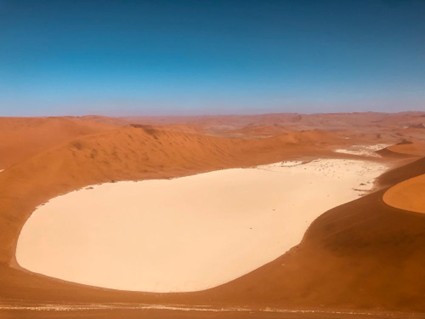
Conclusion
There is a famous philosopher who once said, “One does not hunt in order to kill, on the contrary, one kills in order to have hunted” and this can be argued as the catch-22 situation of hunting in Namibia now. On the one hand, these skills are necessary to provide food and relieve the pressures on an already stressed-out environment; while simultaneously offering hunters the ability to pick up a dream hunting safari at a reduced price in an extended season, just no trophies allowed.
Author: A. Baker
